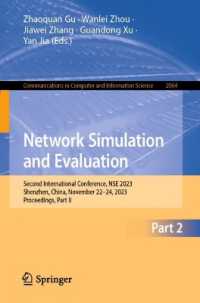Full Description
This book presents an in-depth interrogation of the theory and application of the Basic Structure Doctrine in the Federation of Malaysia.
The Basic Structure Doctrine, famously introduced in the 1973 Indian Supreme decision of Kesavananda Bharati v State of Kerala AIR - which held that certain core or fundamental features in the Constitution of India could not be amended by Parliament even if it met all procedural requirements - was initially rejected when it was first argued in Malaysia in the 1975 case of Loh Kooi Choon v Government of Malaysia and lay dormant for the next three decades.
Judicial winds shifted in 2010 when Malaysia's apex court, the Federal Court, cited Kesavananda with approval in the case of Sivarasa Rasiah v Badan Peguam Malaysia & Anor, and observed that it was 'clear from the way in which the Federal Constitution is constructed that there are certain features that constitute its basic fabric' and that 'any statute (including one amending the Constitution) that offends the basic structure may be struck down as unconstitutional.' In a quick succession of cases, the Federal Court cemented this doctrine in Malaysia's jurisprudence and deployed it to defend the court's judicial power. These widely-publicised cases generated much debate beyond the legal fraternity and judiciary and often polarised different sectors of Malaysian society.
This collection of essays responds to this extremely important debate on the limits of constitutional amendments as a form of constitution-making in Malaysia by considering the theory behind the Basic Structure Doctrine and critically examining how it has been harnessed by the Federal Court and by other political actors - most notably Islamists and secularists; and royalists and republicans - on the ground.
Contents
Constitutional Amendments and the Basic Structure Doctrine in Malaysia: An Overview, Kevin YL Tan (National University of Singapore) and HP Lee (Monash University, Australia)
Part I: Theoretical Overview
1. Executive Supremacy and Judicial Power: Legality as a Constraint on Consitutional Change, Rueban Balasubramaniam (Carleton University, Canada)
2. Government Structures, Parliamentary Constitutionalism and the Basic Structure Doctrine, Andrew Harding (National University of Singapore)
3. Charting Changes to the Constitution: Amendments and the Basic Structure, Kevin YL Tan (National University of Singapore)
Part II: Malaysia: General Perspectives
4. Constitutional Amendments in Malaysia: Some Emerging Issues, Shad Saleem Faruqi (University of Malaya, Malaysia)
5. The Basic Structure in Malaysia: Less than Meets the Eye, Benjamin Joshua Ong (Singapore Management University)
6. Judicial Power and the 'Basic Structure Doctrine' in Malaysia, Wilson Tay Tze Vern (Taylor's University, Malaysia)
7. Basic Structure Doctrine (BSD): A Political View from Sabah and Sarawak, James Chin (University of Tasmania, Australia)
8. Two Forks in the Road: Defending Constitutional Supremacy in the Face of Constitutional Amendments, Emily Ho (Lim Chee Wee Partnership, Malaysia)
9. Examining the Sovereignty of the Malay Rulers under the Basic Structure Doctrine, Mohd Nazim Ganti Shaari (Universiti Teknologi MARA, Malaysia)
10. Political Parties in Parliamentary Democracy: From Lacuna in the Malaysian Constitution's Basic Structure to Anti-Hopping Law, Wong Chin Huat (Sunway University, Malaysia)
Part III: Comparative Perspectives
11. Basic Structure Beyond the Written Constitution, Erin Delaney (University College London, UK)
12. Basic Structure as a Means for Judicial Self-Dealing or Self-Preservation? Placing Malaysia in the Broader Asian Context , Rehan Abeyratne (Western Sydney University, Australia)
13. Protection of the Judicial Power under the Basic Structure Doctrine: Lessons from Australia, HP Lee (Monash University, Australia) and Andrew Foster (Monash University, Australia)








